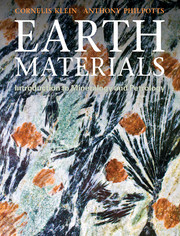Book contents
- Frontmatter
- Contents
- Preface
- Acknowledgments
- Chapter 1 Introduction
- Chapter 2 Materials of the solid Earth
- Chapter 3 How are minerals identified?
- Chapter 4 Fundamentals of crystal structures
- Chapter 5 Introduction to crystallography
- Chapter 6 Minerals and rocks observed under the polarizing optical microscope
- Chapter 7 Igneous rock-forming minerals
- Chapter 8 How do igneous rocks form?
- Chapter 9 Igneous rocks
- Chapter 10 Sedimentary rock-forming minerals and materials
- Chapter 11 Formation, transport, and lithification of sediment
- Chapter 12 Sedimentary rock classification, occurrence, and plate tectonic significance
- Chapter 13 Metamorphic rock-forming minerals
- Chapter 14 Metamorphic rocks
- Chapter 15 Some economic minerals, mainly from veins and pegmatites
- Chapter 16 Some selected Earth materials resources
- Chapter 17 Earth materials and human health
- Glossary
- Minerals and varieties
- Common igneous, sedimentary, and metamorphic rocks
- Index
- References
Chapter 3 - How are minerals identified?
- Frontmatter
- Contents
- Preface
- Acknowledgments
- Chapter 1 Introduction
- Chapter 2 Materials of the solid Earth
- Chapter 3 How are minerals identified?
- Chapter 4 Fundamentals of crystal structures
- Chapter 5 Introduction to crystallography
- Chapter 6 Minerals and rocks observed under the polarizing optical microscope
- Chapter 7 Igneous rock-forming minerals
- Chapter 8 How do igneous rocks form?
- Chapter 9 Igneous rocks
- Chapter 10 Sedimentary rock-forming minerals and materials
- Chapter 11 Formation, transport, and lithification of sediment
- Chapter 12 Sedimentary rock classification, occurrence, and plate tectonic significance
- Chapter 13 Metamorphic rock-forming minerals
- Chapter 14 Metamorphic rocks
- Chapter 15 Some economic minerals, mainly from veins and pegmatites
- Chapter 16 Some selected Earth materials resources
- Chapter 17 Earth materials and human health
- Glossary
- Minerals and varieties
- Common igneous, sedimentary, and metamorphic rocks
- Index
- References
Summary
Identification of minerals in hand specimens is the main emphasis of this chapter. The methods used are careful visual evaluation and basic tests with easily available tools. Only at the end of this chapter do we briefly introduce some sophisticated instrumental methods that are used in the quantitative characterization of minerals and other crystalline solids. Chapter 6 is devoted to the study of minerals with a polarizing optical microscope.
The identification of an unknown mineral in a hand specimen begins with making observations that allow us to assess a specimen’s overall form (or crystal habit if it is well crystallized), state of aggregation, and color. Those properties that allow us to identify a mineral or at least narrow down the possibilities are said to be diagnostic. Color is probably the first property the observer sees, followed by the overall shape of the mineral. But, though instantly noted, color is not a reliable diagnostic property in most minerals, because many (chemically variable) mineral groups exhibit a range of colors.
Important physical properties that characterize a mineral and allow us to separate one from another in hand specimens are the following:
Habit
State of aggregation
Color
Luster
Cleavage
Hardness
Specific gravity (or relative density)
Each of these properties is discussed in this chapter, but it must be recognized that the actual process of mineral identification is best learned in the laboratory part of the course you are enrolled in. There you will tune your observational skills through the study of labeled mineral specimens as well as unknowns. Here, we first introduce those properties that can be evaluated by observation only – habit, state of aggregation, color, and cleavage – and subsequently discuss properties such as hardness, specific gravity, magnetism, radioactivity, and solubility in hydrochloric acid, all of which require testing tools.
- Type
- Chapter
- Information
- Earth MaterialsIntroduction to Mineralogy and Petrology, pp. 38 - 61Publisher: Cambridge University PressPrint publication year: 2012



